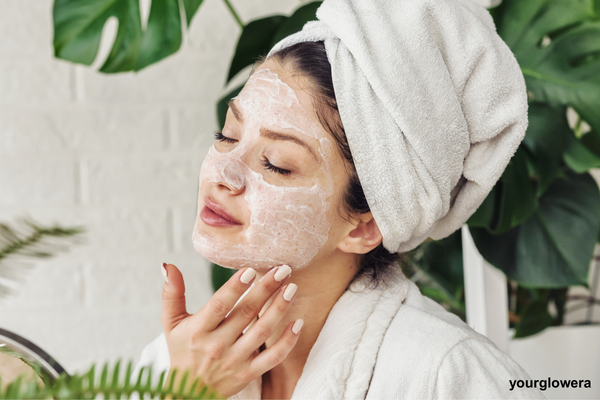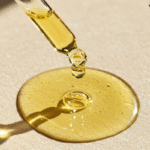Combination skin can be a challenging type to look after. You’ve got the oily T-zone and dry patches on the rest of your face, which means your skin needs a bit of extra care and balance.
But don’t worry! Creating a natural skincare routine for combination skin is simpler than it sounds. The key is to use the right products and ingredients that address both concerns without breaking the bank.
In this post, we’ll walk you through a foolproof natural skincare routine for combination skin, covering the best tips, products, and natural remedies that can help you achieve the perfect balance. Let’s get started!
Table of Contents
What Is Combination Skin? A Quick Overview
Before diving into a skincare routine, it’s important to understand what combination skin is.
If your skin gets oily in some spots (like the forehead, nose, and chin) and dry or flaky in other areas (like the cheeks and jawline), you probably have combination skin.
The key is to take care of both the oily and dry areas at the same time, while making sure your skin stays healthy and glowing with a natural skincare routine for combination skin.
Why You Need a Special Skincare Routine for Combination Skin
Combination skin isn’t a one-size-fits-all type. Since different areas of your face have different needs, you need a tailored approach.
Using harsh products for oil control might worsen the dryness on your cheeks, while moisturizing creams might exacerbate oiliness in the T-zone, highlighting the importance of a natural skincare routine for combination skin.
The proper natural skincare routine for combination skin is important for keeping a healthy, glowing face.
Step-by-Step Guide to Building Your Natural Skincare Routine
Now that you understand what combination skin is, let’s get into the actual steps of creating your routine. Here’s how you can nurture your skin with natural ingredients while balancing oiliness and dryness.
Step 1: Start with a Gentle Cleanser
Cleansing is the initial and most essential step in any natural skincare routine for combination skin you follow. You should choose a cleanser that gets rid of dirt and impurities without taking away the skin’s natural oils.
Best Natural Cleansers for Combination Skin
• Aloe Vera Gel: Aloe vera is hydrating, soothing, and mild enough for both oily and dry skin areas.
• Honey: Honey is a natural ingredient that makes the skin soft and smooth, and it helps to keep the skin clean and moisturized.
• Tea Tree Oil: Tea tree oil has antibacterial properties, making it perfect for tackling breakouts in the T-zone.
How to Use:
Apply a gentle cleanser to damp skin, massage it in circular motions, and rinse with lukewarm water. For extra hydration, use a microfiber cloth to pat your face dry.
Step 2: Exfoliate to Remove Dead Skin Cells
Exfoliation is important for combination skin because it clears away dead skin cells, helping to prevent clogged pores and pimples. But, be cautious not to scrub your skin too frequently, as it may cause irritation.
Top Natural Exfoliants for Combination Skin
• Oatmeal Scrub: Oatmeal gently exfoliates without irritating, making it ideal for both oily and dry areas.
• Sugar and Olive Oil Scrub: Brown sugar mixed with olive oil can hydrate and exfoliate at the same time.
How to Use:
Exfoliate your skin once or twice a week, applying the scrub in circular motions for about 30 seconds. Pay attention to your T-zone but be careful around dry spots.
Step 3: Tone for Balance
A good toner helps balance your skin’s pH levels and tightens pores, which is especially important for combination skin. Toners moisturize dry spots while keeping oil under control in the T-zone, making them an essential part of a natural skincare routine for combination skin.
Natural Toners You’ll Love
• Rose Water: Naturally soothing, rose water hydrates and refreshes the skin.
• Witch Hazel: Great for controlling oil in the T-zone, witch hazel tightens pores without over-drying.
How to Use:
After cleansing, apply your toner to a cotton pad and gently swipe it across your face. Focus on your T-zone, but don’t forget to cover your cheeks and jawline as well.
Step 4: Moisturize to Lock in Hydration
It might seem counterintuitive to moisturize oily skin, but moisturizing is essential for both dry and oily areas. The trick is to choose the right moisturizer.
Best Natural Moisturizers for Combination Skin
• Aloe Vera Gel: Perfect for hydration without greasiness, aloe vera gel works well on both oily and dry areas.
• Coconut Oil: If you’re on the drier side, coconut oil is an excellent natural moisturizer that provides nourishment.
How to Use:
Apply a small amount of moisturizer all over your face, especially on the areas that feel dry. Allow it to absorb fully before continuing with other steps in your routine.
Step 5: Don’t Skip Sunscreen
Sunscreen is non-negotiable in any natural skincare routine for combination skin. It protects your skin from harmful UV rays that can cause premature aging and worsen skin conditions.
Best Natural Sunscreens
• Mineral Sunscreen with Zinc Oxide: Provides excellent protection without clogging pores or irritating sensitive skin.
• Green Tea Sunscreen: Green tea is packed with antioxidants and offers sun protection without leaving a greasy residue.
How to Use:
Apply sunscreen every morning, even on cloudy days. Reapply every two hours if you’re spending time outdoors.
Step 6: Pamper Your Skin with a Face Mask
Incorporating a face mask into your weekly routine can give your skin some extra love. Masks can target specific concerns like dryness or excess oil.
Effective Natural Face Masks for Combination Skin
• Clay Mask: Clay masks help to remove extra oil from your T-zone and give your skin a proper hydration.
• Avocado Mask: Avocado is deeply hydrating and perfect for treating dry areas of your face.
How to Use:
Apply a clay mask on your T-zone and a moisturizing mask on your cheeks to keep your skin properly hydrated. Apply once a week for an added skin boost.
Step 7: Weekly Skincare Routine Adjustments
Combination skin may require a slightly different approach depending on the season or how your skin is feeling. Make sure to adjust your natural skincare routine for combination skin and products to suit your skin’s needs each week.
Budget-Friendly Natural Products for Combination Skin
You don’t have to spend a fortune on skincare to achieve the perfect balance. Here are some budget-friendly options that work wonders for combination skin:
1. Khadi Natural Herbal Face Wash: Budget-friendly, made from natural ingredients, and works well for combination skin.
2. Mamaearth Tea Tree Face Wash: A gentle yet effective product for treating acne-prone T-zones.
3. Plum Green Tea Oil-Free Moisturizer: A lightweight option that hydrates without clogging pores.
Conclusion: Achieving Healthy, Balanced Skin
A simple skincare routine for combination skin doesn’t have to be difficult. With the right products, natural ingredients, and consistent care, you can balance oiliness and dryness to achieve radiant, healthy skin.
Remember to cleanse, exfoliate, tone, moisturize, and protect your skin from the sun. And don’t forget to pamper yourself with a face mask once a week to keep your skin glowing.
Are you wondering whether using vitamin C serum might be triggering breakouts or causing acne? If you’ve experienced skin issues after applying vitamin C products, this blog post is a must-read. Titled “Does Vitamin C Serum Cause Acne? Here’s What You Need to Know!”, it provides clear, expert insights into the common concerns surrounding vitamin C and skin health.
Many people ask, does vitamin c serum cause acne? and this post addresses that question thoroughly, helping you understand how vitamin C interacts with different skin types and conditions. Whether you’re a skincare novice or looking to optimize your routine, understanding the potential effects of vitamin C serum is key to maintaining clear, healthy skin.
By reading this detailed guide, you’ll learn the truth behind whether vitamin C serum causes acne and how to choose the right formulation for your skin. The post covers tips on identifying skin reactions, selecting suitable products, and incorporating vitamin C into your skincare routine without aggravating acne.
If you’re eager to enjoy the brightening benefits of vitamin C while keeping your skin clear, this blog provides essential advice to help you make informed decisions. Dive in now to discover everything you need to know about the safety and effectiveness of vitamin C serum for acne-prone skin.
Frequently Asked Questions (FAQs)
What is the first rule of skincare?
The first rule of skincare is cleanse. Properly cleansing your skin helps remove dirt, oil, and impurities, allowing your skin to absorb the benefits of the other skincare products, especially when following a natural skincare routine for combination skin.
What is the finger rule in skincare?
The finger rule in skincare suggests using your fingertips to apply products, as they are gentler on your skin. Additionally, avoid using too much product, as a small amount is often sufficient for effective results.
What is the 60-second rule in skincare?
The 60-second rule suggests spending 60 seconds massaging your cleanser into your skin as part of your natural skincare routine for combination skin. This helps remove impurities and allows the product to work effectively without over-drying or irritating the skin.
What is the best homemade skin care routine?
For combination skin, a simple homemade routine includes:
1. Cleanser: Mix honey and lemon juice for a natural cleanser.
2. Toner: Use diluted rose water or green tea as a toner.
3. Moisturizer: Aloe vera gel or jojoba oil can help hydrate without over-moisturizing.
4. Exfoliation: Oatmeal and yogurt mask works as a mild exfoliant.
Can we use rose water as toner?
Yes, rose water is a great natural toner for a natural skincare routine for combination skin. It helps balance the skin’s pH, controls oil, and hydrates without making the skin feel greasy, which makes it perfect for combination skin.
How do I know my skin type?
To determine your skin type, wash your face with a gentle cleanser and leave it bare for an hour as part of your natural skincare routine for combination skin. Then observe how your skin feels:
1. Oily: Skin feels greasy, especially in the T-zone.
2. Dry: Skin feels tight and may have flakes.
3. Combination: Oily in some areas (T-zone) and dry or normal in others.
4. Normal: Skin feels comfortable with no excess oil or dryness.
How can I improve my combination skin?
To improve combination skin:
1. Use gentle cleansers that don’t strip your skin.
2. Choose lightweight, non-comedogenic products that hydrate without clogging pores.
3. Exfoliate gently to remove dead skin.
4. Incorporate products with niacinamide or salicylic acid to balance oil production and reduce pores.
Is vitamin C bad for combination skin?
No, vitamin C is not bad for combination skin. In fact, it helps brighten skin tone and provides antioxidant protection. Use a vitamin C serum with a stable formula and avoid using it if you have sensitive or reactive skin. For a natural skincare routine for combination skin, incorporating vitamin C can be beneficial.
How to control face oil naturally?
To control excess oil naturally:
1. Use a mattifying primer.
2. Incorporate niacinamide and salicylic acid into your routine to regulate oil production.
3. Clay masks can absorb excess oil.
4. Keep your skin hydrated to prevent overproduction of oil.
What are the disadvantages of combination skin?
Combination skin can be tricky to manage because different areas require different treatments, so a natural skincare routine for combination skin is essential. The main disadvantages include:
1. Inconsistent hydration: Some parts of your face may be oily, while others are dry.
2. Clogged pores: Oily areas may be more prone to acne and clogged pores.
3. Finding the right products: It can be difficult to find products that work for both oily and dry areas.
What is the key to a natural skincare routine for combination skin?
The key to a natural skincare routine for combination skin is using gentle, plant-based products that cleanse, hydrate, and balance oil production effectively. It’s important to target oily zones without over-drying dry patches. Ingredients like witch hazel, aloe vera, and natural oils help restore skin harmony. A natural skincare routine for combination skin with consistency and choosing the right products tailored for combination skin are crucial to achieving the perfect balance. This approach ensures your skin remains healthy, fresh, and radiant.
Which natural cleansers are best for combination skin?
Mild, natural cleansers containing ingredients like honey, aloe vera, or tea tree are ideal for a natural skincare routine for combination skin. They remove excess oil and dirt from oily zones while nourishing dry areas. These gentle cleansers do not strip away natural oils, maintaining the skin’s moisture barrier. Regular use helps prevent breakouts and dryness, promoting a clear and balanced complexion. Opt for natural cleansers that suit your skin’s specific needs for best results.
Are toners necessary in a natural skincare routine for combination skin?
Yes, natural toners like rose water or witch hazel help restore pH balance, tighten pores, and refresh the skin. They are an essential part of a natural skincare routine for combination skin because they prepare your skin for moisturizers and treatments. Toners also help remove residual impurities and soothe the skin. Using a natural toner daily enhances overall skin tone and maintains harmony between oily and dry areas.
Should I avoid certain ingredients in my natural skincare routine for combination skin?
Yes, avoid harsh chemicals, synthetic fragrances, and heavy oils that can clog pores or dry out your skin. Focus on natural ingredients that are gentle yet effective in balancing oil and hydration. Stay away from alcohol-based products that can cause irritation or dryness. Choosing natural, skin-friendly ingredients ensures your natural skincare routine for combination skin supports overall skin health and prevents future issues.









Leave a reply